I often write out my talks when I am presenting new material – my “live performances” can differ substantially from what I meant to say, depending on how my brain is functioning on any given day, so I feel like it’s useful to share what I meant to say. This time, though, I have other reasons for sharing my text: I had so very much more that I wanted to say.
I wrote a blog post earlier this year about a road trip Amy and I took to a number of “legacy cities” around the eastern Great Lakes. Leetha Filderman, who organizes the PopTech conference, read the post and asked if I’d be interested in developing it into a talk, using the images I’d taken along the way. I had some anxiety about this: I am not an urban planning scholar, and I don’t want to be the guy (always a guy) who wades into someone else’s field with insights about a subject I know nothing about.
So I told Leetha that I would find a way to tie legacy cities to the communities I study online, so that I wasn’t entirely out of my lane. And I told her I planned on shouting out all the books I’ve been reading about legacy cities and pointing people to actual scholarship on the topic.
And then two weeks ago, she told me that all talks at PopTech this year are 8 minutes long.
As you probably know, it takes most academics eight minutes to say hello and introduce themselves. So I had to take a different approach. I prepared a quick, extremely visual talk that should be available on YouTube soon. And I put all the stuff with subtlety, complexity and nuance in the footnotes. Here are those footnotes.

Rochester, NY
It was the third summer of the pandemic and I wanted to rent a van and camp on beaches and generally act like a twenty year old instagram influencer, and my wife pointed out, "We don't camp." "What _do_ we do?", I asked her. "We go to art museums, photograph collapsing buildings and eat cheap ethnic food."
Which is all true, and which is why we went on vacation to Utica, New York. We went to Rochester and Syracuse, and Buffalo and Detroit and Toledo and Cleveland and Erie, too, with a romantic detour to Love Canal. We went to cities that are rarely vacation destinations, that are more likely to be punch lines of jokes. (1) These cities hit their peak population sometime between 1950 and 1970 and have been shrinking since then. (2) In many cases, they've burned, as absentee landlords hired kids with gas cans to torch their houses for the insurance money. (3)
1) To be clear, we’re not beyond humor either – we listened to Randy Newman’s “Burn On” as we drove alongside and over the Cuyahoga River. (Not to mention “Love Canal” by Flipper.) And part of the appeal of the trip was the looks we got from our friends when we told them where we were going on the trip. In truth, though, a significant chunk of this drive was a repeat for us. When Amy moved to the Berkshires from Houston, we took a week to drive up the Mississippi, and discovered to our surprise that the standouts from our trip were Cleveland, Buffalo and Corning, NY. Given our fondness for those cities based on a brief visit, why not design a whole vacation around them?
2) It’s more complicated than that, obviously. Some legacy cities continue to shrink – Detroit’s population is smaller in 2020 than in 2010, and roughly a third of its peak population in the 1950 census. Others are rebounding: Utica is larger in 2020 than 2010, and appears to have bottomed out in 2000. Amy and I tend to glance at the Wikipedia page for cities we’re visiting, and flip immediately to the demographics section. If the population peaked in the 1950s – 1970s and is significantly lower now, it’s likely a post-industrial legacy city, and a place we would enjoy visiting. (Perhaps it’s not a surprise that we live on the outskirts of Pittsfield, MA, where the population peaked in the 1960 census, is now at 75% of peak and continues to shrink.)
3) It was fascinating and horrifying to realize what a common theme the burning of cities was throughout the trip. I’ve recently read Joe Flood’s “The Fires”, both because I’m fascinated by the history of The Bronx and by the incredible example of RAND’s model for how to optimally fight fires in NYC failing dismally when faced with the political realities of closing fire stations. (Yes, RAND’s models made unsupportable assumptions about NYC traffic, but it’s likely that impacts were more severe from political pressures to keep fire stations open when they happened to be located near influential politicians.)
We read a great deal about the fires in Detroit on our trip. The Devil’s Night fire tradition – in which vandals burned abandoned buildings on the eve of Halloween – in Detroit seems to have finally ended, but it’s amazing to consider the scale of the phenomenon. In 1984, 800 buildings reportedly burned across the city in a single night. Reading about Tyree Guyton’s Heidelberg Project, I was struck by how many of the buildings he transformed were either burned by arsonists, or destroyed by the city. And while the fires on the Cuyahoga river are a bit of history I knew before the trip, I had not known about the Hough Riots, in which many Black-owned properties burned.
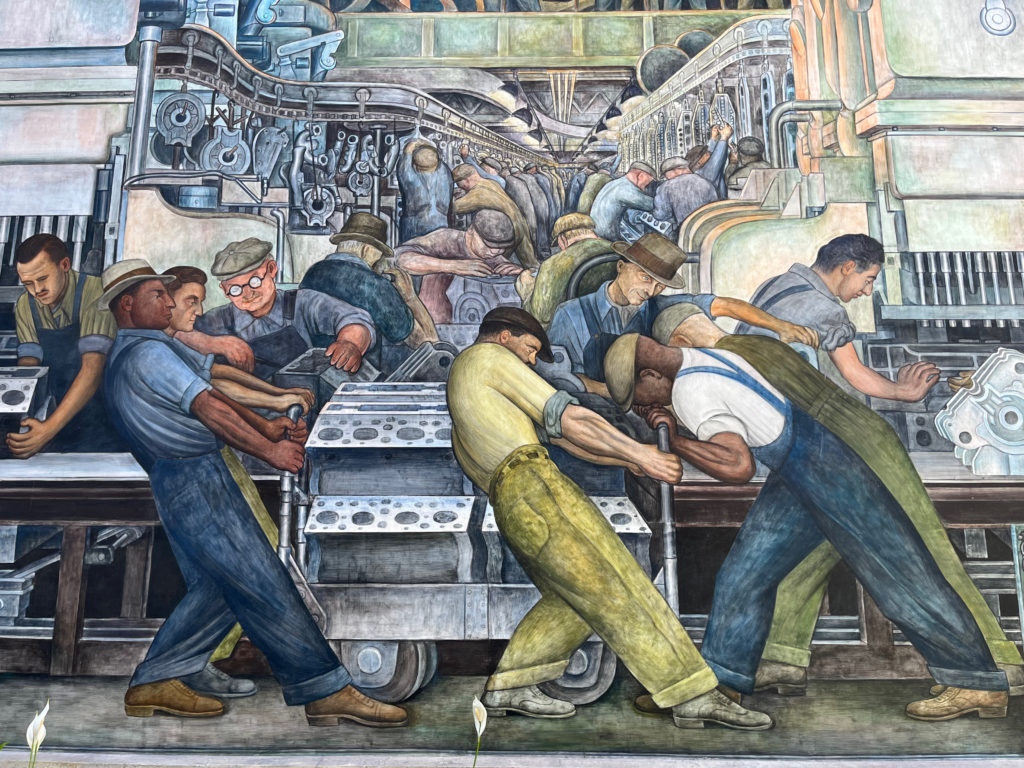
Detail from Diego Rivera’s “Detroit Industry”
Planning the trip, we called it "the rustbelt ramble", but somewhere between Utica and Rochester, we started using the term "legacy cities" instead (4). The splendid buildings, the museums, the parks, the cemeteries are a legacy bequeathed by an older America to her grandchildren. The US park service makes passports to let us collect visits to National Parks: we need a legacy city passport where you get a stamp for seeing Diego Rivera murals in Detroit, George Eastman's House in Rochester or eating beef on weck in Buffalo.
4) The term “legacy city” appears to have been coined by the American Assembly of Columbia University, as a more representative term than “shrinking cities” or “post-industrial cities”. The American Assembly’s definition included cities of 50,000 or more, with greater than 20% population loss. Pittsfield, for instance, falls outside this definition as population loss now means we’re below 50k… Researcher Alan Mallach identified 48 cities that fit these criteria, and they are clustered in the Northeast and the Midwest. A few southern cities make the list – Birmingham, Macon and New Orleans – as do some surprising coastal cities – DC and Baltimore. But post-industrial upstate NY and midwest (Ohio, PA, Michigan) have the highest concentration of these places. See 2015’s Mapping America’s Legacy Cities for more.
Mallach edited the book I’ve found most helpful on legacy cities thus far, “Rebuilding America’s Legacy Cities”.
But I'm an old software developer, and I know that "legacy systems" are old, outdated code that's incompatible with current systems (5), and that's true of these cities too. As cities shrink, there's fewer people to pay taxes to support infrastructures that were meant to serve two or three times as many people as live in Cleveland or Detroit today. And so legacy cities feel weird - they feel empty, abandoned, unsuited to this moment in history.
5) The term “legacy systems” was everywhere in the 1990s when I was a software developer and a manager of developers – I’ve gotten some blank stares when I’ve bounced the term off contemporary developers. Perhaps it was a particular concern pre-Y2K – I am old enough to remember taking the Y2K bug very seriously and trying to ensure our systems would switch millenia without significant downtime.
I study online communities, and one thing my colleagues and I have learned is that every community contains within it a vision of the good life, the way things ought to be. Facebook assumes the good life is one where the people we know online are exactly the same as the people we know offline. Twitter assumes that we all want to be on the news, as reporters or commentators. YouTube assumes we are all reality TV stars. These assumptions about what constitutes a good life online structures their affordances, the possibilities they make available to us.(6)
6) Chand Rajendra Nicolucci and I wrote a brief book – An Illustrated Field Guide to Social Media – based on the idea that different platforms have different “logics” for how they operate. As we’re revising and expanding that book, I’m wondering if those logics are better understood as visions of what social media is supposed to be… and how that maps to the idea of cities and the good life. I don’t know whether this mapping between communities and cities is one I’ll want to explore long-term, but it’s helping me think about my obsession with legacy cities and the ways they differ from rapidly growing American cities.
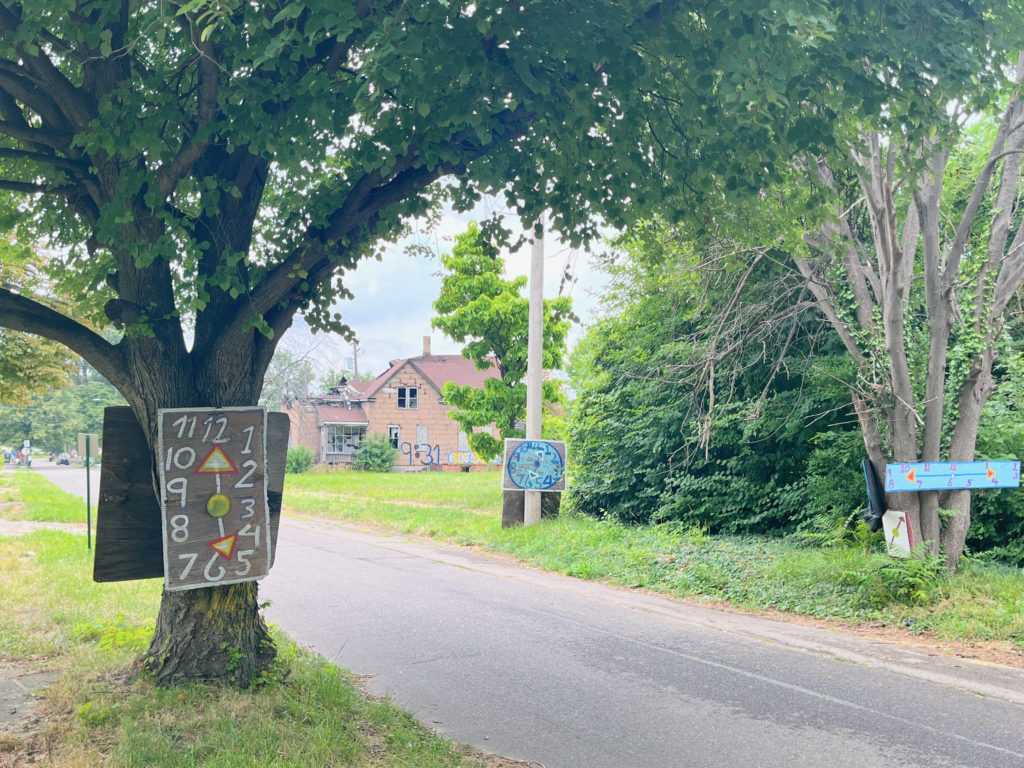
Section of the Heidelberg Project, Detroit, MI
Legacy cities feel weird because they represent an earlier vision of the good life, one where you aspired to a union, factory job, a small house in a neighborhood with local stores and streetcar lines, where your kids walk to school. Many of us gave up on that vision of the good life sometime in the 1970s, as jobs moved to the non-union south and eventually to Mexico, where people moved from Toledo to Florida and Texas and Arizona, where the good life means you can ignore the physical world, that you never need to be hot or cold, that you can have as much space as you could want.(7) Orlando and Houston and Phoenix, fast-growing cities that are only possible due to the automobile and air conditioning, are less densely populated than Detroit, even after Detroit lost 2/3rds of its population.(8)
7) The cities that grew the most in the 1990s – present have been in the South and the Southeast. Florida, Texas and Arizona, in particular, have grown explosively. This seems increasingly strange to me as climate change threatens to make these locales less desirable (at least to me, but I actually like snow.)
There’s tons to read about the anti-union South. This article from Ken Green at UnionTrack offers some reasons: as the north industrialized, the south often positioned itself as agricultural and opposed to unionization. Racial dynamics came into play as well – when white workers went on strike, Black workers were brought in (and fired when the strike was broken), making it hard to achieve solidarity between Black and white workers in the same factory. This excellent piece by Meagan Day on a failed union effort in Winston-Salem in 1946 looks into the racial dynamics of union opposition in detail.
8) Densely packed northern cities like New York City, Boston and Chicago have densities of more than 10,000 people per square mile. Detroit was that dense in its heyday, but in losing 2/3rds of its population, it now has the density of a newer city like Las Vegas, close to 5,000 people per square mile. New, rapidly expanding cities like Phoenix and Houston are between 3,000 – 4000 people per square mile. Some cities that have boomed recently – Jacksonville, FL, Nashville, TN – are even sparser at 1500 people per square mile. It’s amazing to think that Detroit could lose two out of three people and still be denser than many Southern cities.

Detail from Dabl’s African Bead Gallery and Mnad Museum, Detroit, MI
What this means is that legacy cities belong to the people who stay and for the people for whom they still represent a better life. Detroit has become a Black city, roughly 80% African American, and from restaurants and art galleries downtown to abandoned houses converted into Afrofuturist wonderlands, it's clear that the Detroit version of the good life is a lot more vibrant than a Starbucks on every corner.(9)
In 2021, 77.1% of Detroiters classified themselves as “African American Alone” and 14.4% as “White alone”. That’s a pretty neat inversion of the demographic split in the US as a whole, which is roughly 76% white, 14% Black.
I am reading Herb Boyd’s excellent “Black Detroit: A People’s History of Self-Determination”. And I was struck by how many of the rebuilt landscapes I saw in Detroit read to me as Afrofuturist, particularly Olayami Dabls’s amazing Mbad African Bead Museum, which is one of my favorite places in the world. That this place is not an international pilgrimage destination for arts fans is a crime. I had the pleasure of talking with Dabls on my last visit to Detroit. He became a collector of African beads not by travelling to the continent, but by building friendships with travellers who brought drums, clothing and other cultural goods from Accra and Lagos to the Black community in Detroit, Chicago and other midwest cities. Dabls is enormously grateful to those travelling merchants for building a connection between his experience in Detroit and the cultural heritage of the African continent.
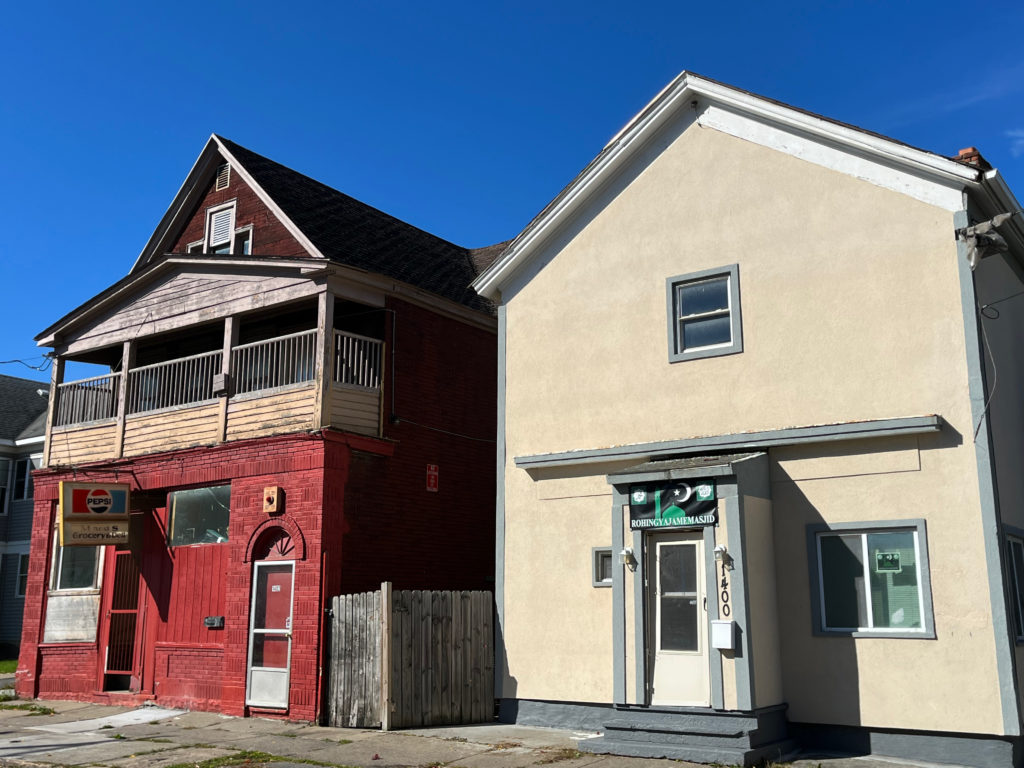
Rohingya Masjid in Utica, NY
Utica is a refugee city - it welcomed Amerasian refugees from Vietnam in the 70s and 80s, Bosnians fleeing civil war in the 1990s. It has welcomed a wave of Karen refugees from Burma and Somali Bantu people from Somalia and Kenya. The city is no longer shrinking and the population is more than one quarter refugees. Which means that the former Methodist church is now a Bosnian mosque, and that the restaurants are Somali and Cambodian and Dominican. (9) Hamtramck, a suburb of Detroit, is now America's primarily Muslim-governed city, thanks in part to Iraqi and Syrian refugees displaced by ISIS. (10)
9) Utica rocks. It’s one of the smallest cities I’m discussing in this talk, and the one closest to where I live – it’s a little more than a two hour drive for me. The NPR radio station I listen to serves Utica as well, so I get occasional glimpses of what’s going on culturally, and it’s wonderful to be able to visit as a day trip.
Susan Hartman has an excellent new book, “City of Refugees”, which tells the story of three refugee families and their lives in the city. Earlier this summer, the New York Times ran an excellent essay and photo series based on her reporting. (We were in Detroit when it came out.) A quick TL:DR; on why Utica has been such a great town for refugees – affordable housing (lots of multifamily houses on the market for $60k – live upstairs, rent the ground floor to your countrymen); local employers willing to hire refugees (Chobani yogurt, local casinos); supportive religious community (Bosnians building a religious infrastructure that’s made it easier for Iraqis, Rohingya, Somali Bantu populations.)
10) Hamtramck is historically a Polish immigrant community, and until 2021, every mayor had been Polish-American. But there’s been massive growth of the Bengali and Yemeni populations, as well as refugee populations in both Hamtramck and Dearborn, and Hamtramck now has a Yemeni Muslim mayor and a Muslim majority city council.
My lab at UMass studies refugee spaces online, too. When your interests or your politics are too outside the mainstream for Facebook, you end up building your own, new spaces online. When sex workers got kicked off of Craigslist and Backpage shut down, a few of them built switter.at - sex worker Twitter - a space designed by sex workers where they could share information about problematic clients and create a safer space for their work online.(11) My colleagues and I tend to think refugee communities online are the most dynamic and informative spaces we study. Rather than following the logic of the marketplace - one size fits all communities for a billion people - spaces for refugees online develop their own cultures and technologies based on what people want and need. These spaces are not all the same - they're a petri dish evolving different ways to live online.
11) I have written about Switter in my essay, The Good Web, and interviewed two of the project’s founders on Reimagining the Internet.
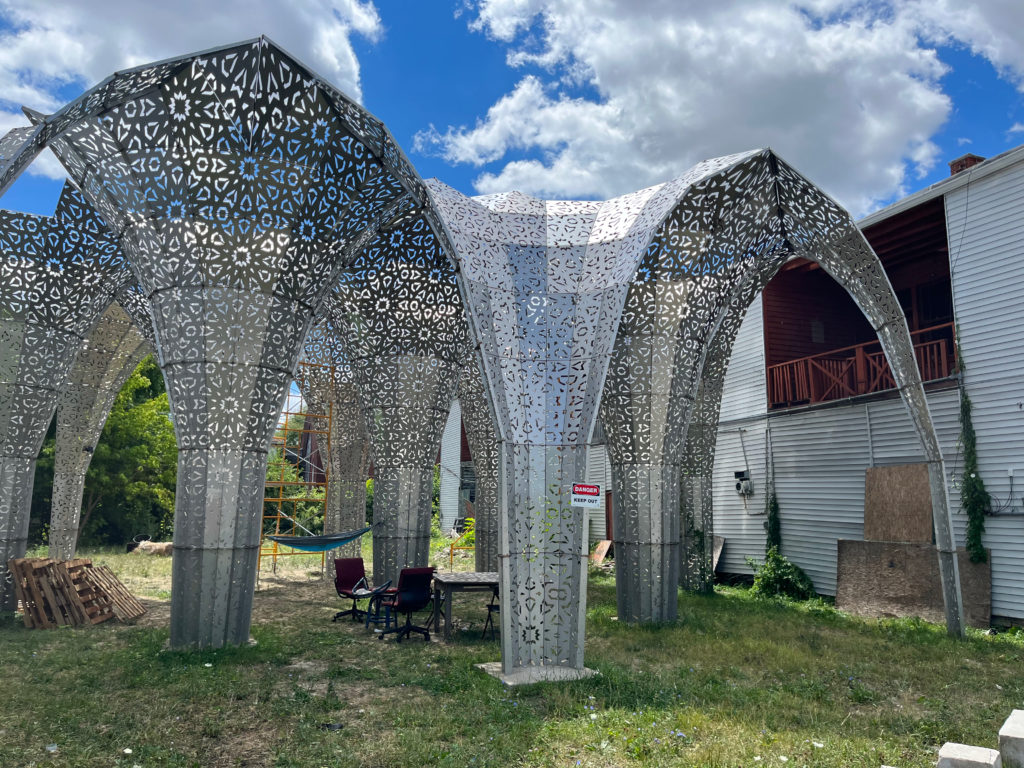
American Riad, an indoor/outdoor space in Detroit, MI.
That's something we could use in physical space, too, whether it's Moroccan riads transforming Detroit streetcorners or a global food mall in Buffalo.(12)
12) I’m grateful to my friend Hasan Elahi for directing me to the American Riad, a gorgeous effort to reimagine a stretch of houses in Detroit as an indoor-outdoor space inspired by Moroccan architecture. The project was incubated by the marvelous Ghana Think Tank, which sets up laboratories in developing nations to solve first-world problems.
The Global Food Mall in question is The West Side Bazaar, where I had my favorite meal of 2022 at a South Sudanese restaurant. Unfortunately, the Bazaar had a fire in late September and is now closed for rebuilding.
And we should take refugee cities seriously, because in the next few decades, a lot of us are going to become refugees. As the South gets hotter, the West gets drier, as coastal cities flood, my guess is that a lot of people will be leaving their home towns.(13) It's not hard for me to imagine what Phoenix might look like in a few decades, when the water runs out. I'm guessing it looks a lot like the Salton Sea, that magical resort in the desert an easy drive from LA, which is now abandoned and plagued with toxic dust storms. (14)
13) I have a document filled with footnotes about the increasing uninhabitability of the southern US, but this package of reporting from Pro Publica is an amazing overview.
14) A good start on the amazing saga that is the Salton Sea is this brief photo essay. If you’re hooked, try the documentary Plagues and Pleasures on the Salton Sea, narrated by John Waters.
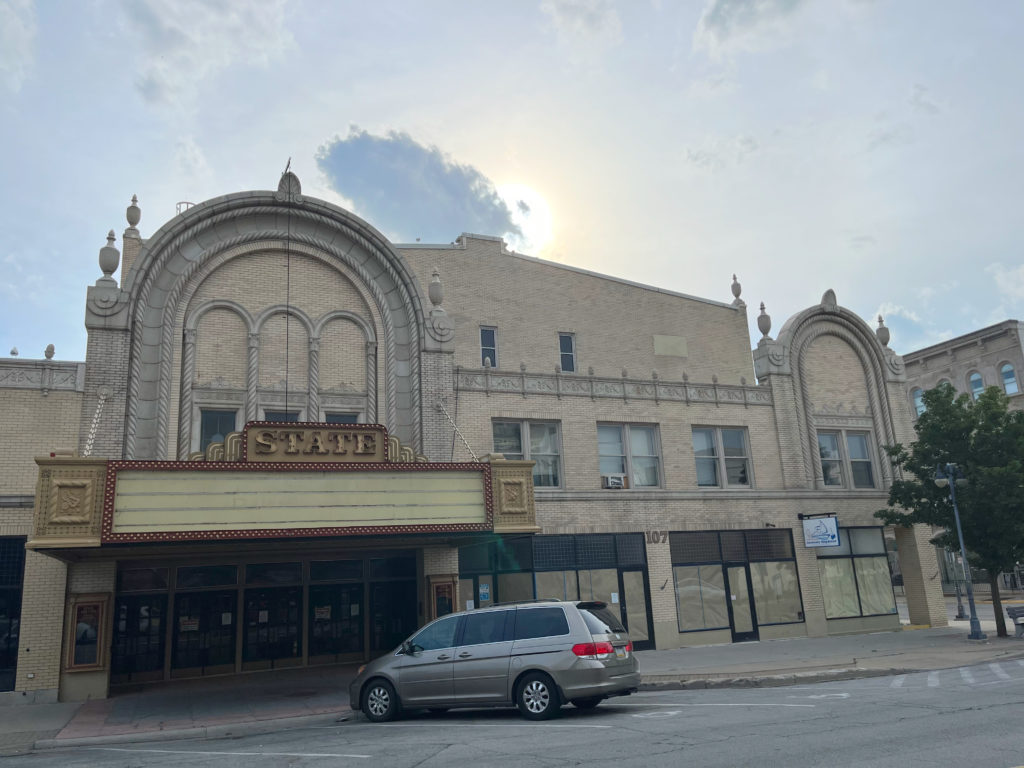
Sandusky, OH
You what's gonna be a great place to live in about thirty years? The Great Lakes. They've got 21% of the world's fresh water.(15) The farmland that surrounds these legacy cities is projected to get more lush and productive. The extreme heat that will make America's fastest growing cities uninhabitable will be a whole lot more tolerable a thousand miles north.
15) Yep. 21% of the _world’s_ fresh water, and something like 90% of the fresh water in the US. It already provides drinking water for about 30 million US citizens and about 30% of all Canadians. And before you get the clever idea of piping Lake Superior to Phoenix, let me point out a) the Rocky Mountains and b) the Great Lakes Compact anticipates this and prohibits it.
But you should probably buy now. Because Pakistan is already under water(16) and there's Ukranians and Russians on the move. The cities Americans lived in from the 1860s to the 1960s turn out to be well suited to a world where we bike instead of drive, where we get on trains instead of planes, and where we look for cultural treasures and inspirations from our neighbors and from the institutions built by our grandparents rather than from overseas.
16) Even with photos and maps, it’s tough to understand the scale of flooding Pakistan experienced in 2022. The UN estimates that at least 33 million people – one in seven people in the country – have been displaced or otherwise affected.
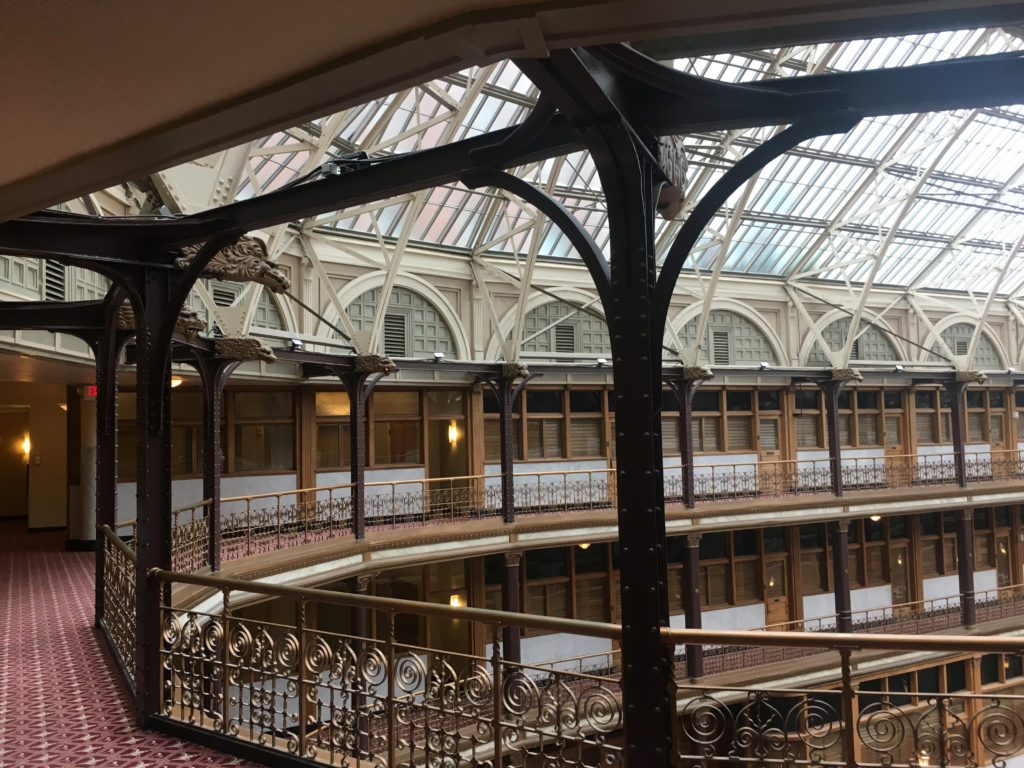
Cleveland Arcade, Cleveland, OH
When you visit America's legacy cities, you feel eras in history beginning and ending. You move from canals to railroads to highways as you walk across town, from cotton mills to electronics factories to software startups. Like New York City, which burned and shrank in the 70s and 80s before once again becoming the capitol of the world, America's legacy cities will come back. I just hope you can find a nice Rohingya landlord willing to rent to you.
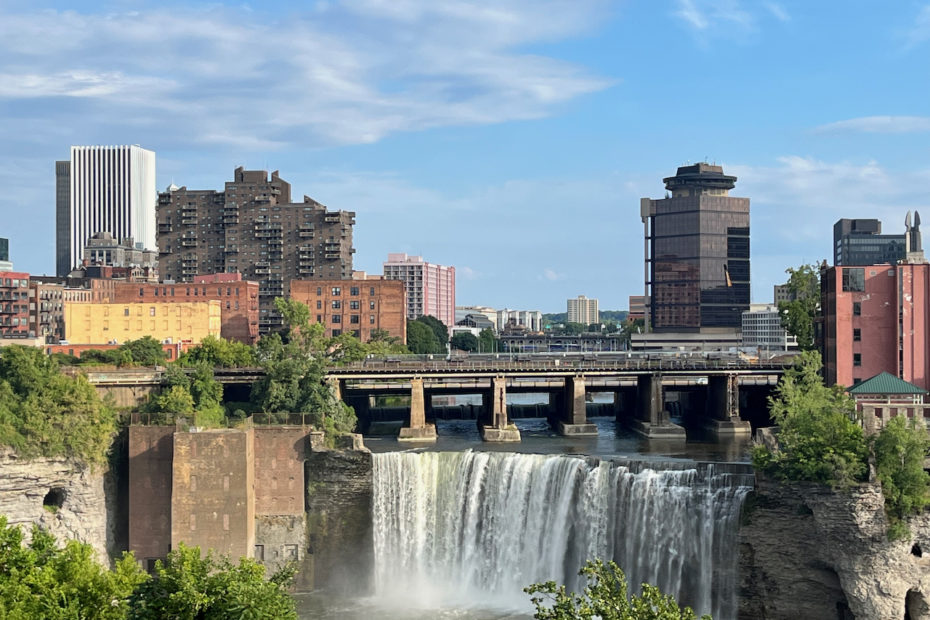
Arrived here after reading your August blog about this trip linked from John Naughton’s “Memex 1.1” diary entry for November 3rd.
Ten years ago my son and I made a road trip starting from Chicago to Green Bay for a Packers game (he’s a big fan) and including the overnight Lake Shore Amtrak to Buffalo Depew for a quick visit to Niagara (and Canada for lunch!) Although we made a great many memories on that trip, my mind often goes back to the train ride into Buffalo; past the abandoned steelworks, railway marshaling yards and electricity infrastructure.
As soon as I could, I googled Buffalo and discovered a significant place in American urban industrial development. Who knew? The 15th most populous US city in 1950. I wondered what more have might have been left behind and I locked away the idea to come back.
Your delightful blog and photographs have just re-triggered that thought and, as well as an “unmissable Long Read IMHO” (JN), it reads like a perfect travel itinerary – paper copy required.
So, thanks for the original blog. Thanks for the update. Congratulations on your wedding. And thanks to Amy for reminding you that “we go to art museums, photograph collapsing buildings and eat cheap ethnic food”. Just what we like to do!
Comments are closed.